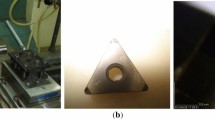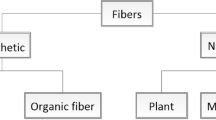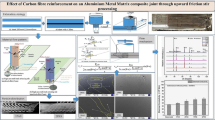Abstract
The current cutting strategies for carbon fiber–reinforced polymer (CFRP) inherit essentially from metal cutting. The frequently occurred damages such as burrs, cracks, and delamination suggest that the existing strategies may not be the best choice for CFRP cutting. This study proposed a sliding cutting strategy especially for CFRP. The novelty is adding an extra lateral velocity on cutting edge to act sliding motion between fiber-matrix and the cutting edge. Then the stress in the materials in front of cutting tip will become more concentrated, which will help to break fibers in desired positions. Thus, the machining quality can be improved. The sliding cutting process was analyzed, and experiments were conducted to examine the proposed strategy. Two types of cutting tools that offered sliding and orthogonal cutting were designed. Four factors, namely machined surface roughness, subsurface damages, forces, and tool wear, were obtained to evaluate the cutting quality. Results show that sliding cutting has more advantages than orthogonal cutting in the four aspects.











Similar content being viewed by others
Availability of data and material
The datasets generated during and/or analyzed during the current study are available from the corresponding author on reasonable request.
Code availability
Not applicable.
References
Zhang X, Chen Y, Hu J (2018) Recent advances in the development of aerospace materials. Prog Aerosp Sci 97:22–34
Wang X, Zhang L (2003) An experimental investigation into the orthogonal cutting of unidirectional fibre reinforced plastics. Int J Mach Tools Manuf 43(10):1015–1022
An Q, Cai C, Cai X, Chen M (2019) Experimental investigation on the cutting mechanism and surface generation in orthogonal cutting of UD-CFRP laminates. Compos Struct 230:111441
Calzada K, Kapoor S, Devor R, Samuel J, Srivastava A (2012) Modeling and interpretation of fiber orientation-based failure mechanisms in machining of carbon fiber-reinforced polymer composites. J Manuf Process 14(2):141–149
Li H, Wang J, Wu C, Zhao C, Zhu W (2020) Damage behaviors of unidirectional CFRP in orthogonal cutting: a comparison between single- and multiple-pass strategies. Compos B Eng 185:107774
Usui S, Wadell J, Marusich T (2014) Finite element modeling of carbon fiber composite orthogonal cutting and drilling. Procedia Cirp 14:211–216
Hassouna A , Mzali S , Zemzemi F, Mezlini S (2020) Orthogonal cutting of UD-CFRP using multiscale analysis: finite element modeling. J Compos Mater 808734360
Liu Y, Li Q, Qi Z, Chen W (2021) Scale-span modelling of dynamic progressive failure in drilling CFRPs using a tapered drill-reamer. Compos Struct 278:114710
Xu J, Mansori M (2016) Cutting modeling of hybrid CFRP/Ti composite with induced damage analysis. Materials 9(1):22
Shen Y, Yang T, Liu C, Liu S, Du Y (2021) Cutting force modeling in orthogonal cutting of UD-CFRP considering the variable thickness of uncut material. The International Journal of Advanced Manufacturing Technology 114:1623–1634
Su Y (2019) Effect of the cutting speed on the cutting mechanism in machining CFRP. Compos Struct 220:662–676
Fu Q, Wu S, Li C, Xu J, Wang D (2022) Delamination and chip breaking mechanism of orthogonal cutting CFRP/Ti6Al4V composite. J Manuf Process 73:183–196
Meng Q, Zhang K, Cheng H, Liu S, Jiang S (2014) An analytical method for predicting the fluctuation of thrust force during drilling of unidirectional carbon fiber reinforced plastics. J Compos Mater 49:699–711
Pereszlai C, Geier N (2020) Comparative analysis of wobble milling, helical milling and conventional drilling of CFRPs. The International Journal of Advanced Manufacturing Technology 106(9–10):3913–3930
Tashiro T, Fujiwara J, Asahi N (2016) Cutting characteristics in end-milling of CFRP with diamond-coated herringbone tool. Int J Automa-tion Technol 10(3):356–363
Jia Z, Fu R, Niu B, Qian B, Bai Y, Wang F (2016) Novel drill structure for damage reduction in drilling CFRP composites. Int J Mach Tools Manuf 110:55–65
Yu Z, Li C, Kurniawan R, Park K, Ko T (2019) Drill bit with a helical groove edge for clean drilling of carbon fiber-reinforced plastic. J Mater Process Technol 274:116291
Qiu X, Li P, Li C, Niu Q, Chen A, Ouyang P, Ko T (2019) New compound drill bit for damage reduction in drilling CFRP. International Journal of Precision Engineering and Manufacturing-Green Technology 6:75–87
Su F, Zheng L, Sun F, Wang Z, Deng Z, Qiu X (2018) Novel drill bit based on the step-control scheme for reducing the CFRP delamination. J Mater Process Technol 262:157–167
Jia Z, Zhang C, Wang F, Fu Y, Chen C (2020) An investigation of the effects of step drill geometry on drilling induced delamination and burr of Ti/CFRP stacks. Compos Struct 235:111786
Astakhov V (2010) Geometry of single-point turning tools and drills. Springer
Meng Q, Cai J, Cheng H, Zhang K (2020) Investigation of CFRP cutting mechanism variation and the induced effects on cutting response and damage distribution. The International Journal of Advanced Manufacturing Technology 106:2893–2907
Zhang C, Chen L, Xia J, Zhang J (2019) Effects of blade sliding cutting angle and stem level on cutting energy of rice stems. International Journal of Agricultural and Biological Engineering 12(6):75–81
Li C, Zhao Y, Qiu X, Li S, Niu Q, Li P, Ko T (2022) Interface mechanical damage mechanism in machining carbon fiber-reinforced plastic/Ti stacks based on a three-dimensional microscopic oblique cutting model. Compos Struct 279:114737
Wang H, Pei Z, Cong W (2020) A feeding-directional cutting force model for end surface grinding of CFRP composites using rotary ultrasonic machining with elliptical ultrasonic vibration. Int J Mach Tools Manuf 152:103540
Funding
This work was supported by the Natural Science Foundation of Liaoning Province (grant number 2021-BS-194).
Author information
Authors and Affiliations
Corresponding author
Ethics declarations
Ethics approval
Not applicable.
Consent to participate
Not applicable.
Consent for publication
All authors agree to be published in The International Journal of Advanced Manufacturing Technology.
Conflict of interest
The authors declare no competing interests.
Additional information
Publisher's Note
Springer Nature remains neutral with regard to jurisdictional claims in published maps and institutional affiliations.
Rights and permissions
Springer Nature or its licensor holds exclusive rights to this article under a publishing agreement with the author(s) or other rightsholder(s); author self-archiving of the accepted manuscript version of this article is solely governed by the terms of such publishing agreement and applicable law.
About this article
Cite this article
Meng, Q., Huang, Z., Cai, J. et al. An investigation on a new sliding cutting strategy for carbon fiber–reinforced polymers. Int J Adv Manuf Technol 121, 7263–7272 (2022). https://doi.org/10.1007/s00170-022-09826-5
Received:
Accepted:
Published:
Issue Date:
DOI: https://doi.org/10.1007/s00170-022-09826-5




